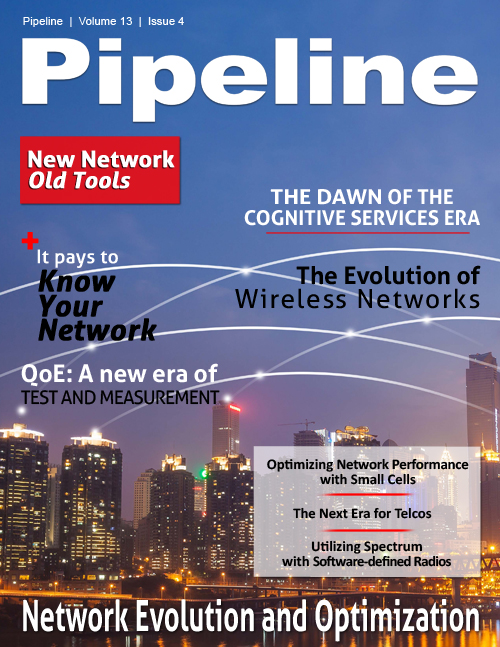By: Adrian Alonso
The human body has been the biggest beneficiary of technology advancements in modern times. There is not a living human function that hasn’t been monitored, repaired or managed with
sophisticated tools. The same should be said for the networks that are the lifeblood of today’s anytime, anywhere communications. But too often, CSPs and large enterprises are working
with tools that are out-of-date, highly customized, and temperamental, rendering some connections DOA. Genesis: Network Management Tools Market Born of Necessity Whether you’re in telecom and
call it ‚Äėservice assurance‚Äô, or you‚Äôre in enterprise and call it ITSM (Information Technology Service Management), managing a vast network of voice, data, media and applications has grown
significantly more complex in the past ten to fifteen years…
¬Ľ read this article
By: Rick Lievano
Every few years a new technology emerges to a point where it significantly impacts the world in which we live ‚Äď both personally and professionally. In the last decade, the advent of
virtualization and cloud computing significantly altered the software market, ushering in a range of new products and services and a new methodology for managing both. By contrast, ‚ÄúBig Data‚ÄĚ has
failed to reach the full potential that its proponents evangelized. Big Data has led to lots and lots of data, but only limited actionable results…
¬Ľ read this article
By: Avi Freedman
The world today runs on networks, so it pays to know your network; but that knowledge can only come through a new scale of network visibility. In just over two decades since the dawn of the
World Wide Web, we have come to depend almost completely on high-speed networks for all aspects of modern life, including business, education, news, politics, entertainment, shopping and
socializing. Due to such pervasive utilization, network operators are finding that they need better ways to monitor performance and detect incoming attacks…
¬Ľ read this article
By: Basem Anshasi
With the exponential growth of mobile data traffic, wireless operators globally are investing heavily on infrastructure including base stations, Distributed Antenna System (DAS), small cells
and others to satisfy the demand of the users. However, the wireless operators’ competitive landscape has changed and revenue is no longer keeping pace with the capital (CAPEX) and operational
(OPEX) expenditures. Therefore, new business models are needed for the wireless operators to find new sources of revenue and remain competitive…
¬Ľ read this article
By: Chris Chapman
Monumental changes in how companies test and measure their networks and network devices do happen; but they tend to happen slowly, only once every ten years or so. Today, we’re at a tipping
point. Companies need to move beyond legacy Quality of Service (QoS) tests and begin focusing on Quality of Experience (QoE).What QoE uncovers is the actual experience of the people who use the
networks and the application services riding on top. It calculates metrics based on historical trends and measurements against baselines that define minimum acceptable quality…
¬Ľ read this article
By: Philip Sorrells
Densifying macro cellular networks is the most viable and well-proven way to increase overall capacity, but more interference risk is the key challenge to increasing densification. With more
frequency bands and wireless technologies available, more potential arises for intra-cellular interference and passive intermodulation (PIM). Mobile operators need a comprehensive toolkit of
solutions for reducing interference to optimize network performance. Densification comes with interference The outdoor wireless landscape is changing, and specialized outdoor small cells known as
metro cells are playing an increasingly large role…
¬Ľ read this article
By: Nitin Serro
Transformation is nothing new to the telecommunications industry. In fact, it’s pretty much a given. The breakup of the Bell system more than two decades ago encouraged competition amongst
service providers, all striving to provide additional value in a commodity space. Technology later created a new competitive dimension. Wireless communications, mobility, and the advent of smart
phones and tablets that began with the introduction of the first iPhone in 2007, all triggered a drastic change within the industry…
¬Ľ read this article
By: Brandon Malatest
Software-defined radios (SDRs) are highly adaptable wireless devices that are (re)configurable through software alone, enabling them to be effectively utilized across multiple communication
standards. SDRs have rapidly become the leading wireless solution for military, public safety, and commercial markets. This can be directly attributed to their high flexibility, performance, and
low-cost. History of Software-Defined Radio Software-defined radios have been around for more than three decades. From the early 1980s, SDRs have played a role in tactical military communications
from 2 MHz to 2 GHz and offer interoperability between various air interface standards of the military…
¬Ľ read this article
By: Tim Young
‚ÄúWe're supposed to keep evolving. Evolution did not end with us growing opposable thumbs. You do know that, right?‚ÄĚ - Bill Hicks If you know anything about Bill Hicks‚ÄĒa true comic
genius, chain-smoking and acerbic, who died far too young more than 20 years ago‚ÄĒyou know that he would hate that a square like me quoted him in a tech magazine. But his point here, which I can‚Äôt
help but read with his trademark bluster, works within the context of our topic for this month: network evolution and optimization…
¬Ľ read this article
By: Jim Schakenbach
The rapid growth of the Internet of Things (IoT) continues to make news this month as Verizon and Qualcomm double down on IoT by announcing a joint initiative to simplify IoT application
development and transform customer experience through Verizon's ThingSpace IoT platform-as-a-service and Qualcomm's LTE modem technology. Through this collaboration, the companies are now on a path
to make the opportunity-cost of connecting intelligent devices on 4G LTE more compelling by using Category M1 as the new standard and LTE's superior security, reliability and reach…
¬Ľ read this article

















